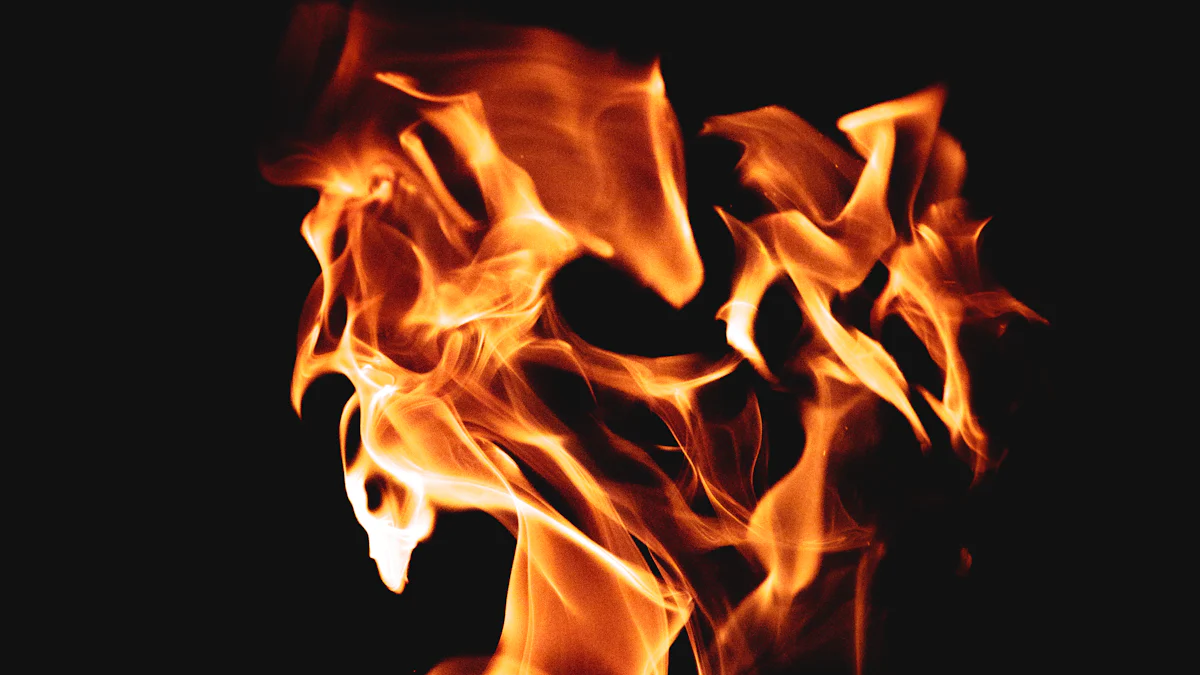
インフォメーション タックコーティングは、高度な材料特性により、極端な熱環境で優れた性能を発揮します。 化学蒸気沈着(CVD)プロセスは、酸化への顕著な熱安定性と抵抗を提供する、タンタルカーバイドの均一で高純度の層を保証します。 このコーティングは2000°Cを越える温度で安定した残ります、それの強い熱への延長された露出を要求する適用のための理想的な選択をします。 大気圏やエネルギー分野などのコンポーネントの耐久性を高める能力は、過酷な条件下での信頼性が重要でない業界において重要な役割を果たしています.
要点
- インフォメーション タックコーティングは、極端な熱用途に理想的な2000°Cを超える温度で優れた熱安定性、残りの機能を提供します.
- コーティングの優秀な酸化および耐食性は部品の寿命を延長しま、大気空間およびエネルギーのような企業の維持費を削減します.
- 高温伝導率の高いCVD TaCコーティングは、高温反応器および炉の局所的な過熱および高める性能を防ぐ熱を効率的に分配します.
- その機械的強度と耐久性は、耐摩耗性と熱衝撃性を保証し、要求の厳しい環境でツールやコンポーネントの信頼できる選択を実現します.
- インフォメーション TaCコーティングは熱応力の下で構造の完全性を維持し、より長続きがする保護を提供することによって、陶磁器および金属のような他のコーティングを、処理します.
- CVD TaCコーティングの汎用性は、航空宇宙および高度な製造における重要なコンポーネントの信頼性を高める、さまざまな基質と効果的に結合することができます.
- CVD活用 タックコーティングは、工具交換の頻度を減らし、作業効率を向上させることで、コストを大幅に削減し、生産性を向上させることができます.
CVD TaCコーティングの主な特性

優れた熱安定性
高融点タンタルカーバイド(3800°F/2100°C以上).
タンタルカーバイド(TaC)は、既知の化合物の中で最も高い融点の1つを誇り、印象的な3880°C(7000°F以上)に達します。 この卓越した熱特性により、 CVD TaCのコーティング 極端な熱にさらされる用途に好まれる選択肢。 高融点は、コーティングが航空宇宙やエネルギー分野など、最も要求の厳しい環境でも安定して機能し続けることを保証します.
長期にわたる熱暴露の下で構造的完全性を維持します.
タンタルカーバイドの化学的安定性は、高温への長期暴露中にその構造的完全性を保持することができます。 熱応力で劣化・変形する多くの材料とは異なり、, CVD TaCのコーティング 機械的特性を維持し、一貫した性能を保証します。 この耐久性は、タービンブレードや熱シールドなどのコンポーネントにとって重要であり、故障することなく長時間の熱に耐える必要があります.
優秀な酸化および耐食性
高温の酸化および化学反応に対する保護障壁.
CVD TaCのコーティング 酸化および化学反応から基質材料を保護する強い障壁を形作ります。 高温環境では、酸化は材料を弱め、機能性を損なうことができます。 タンタルカーバイドレイヤーは、コーティングされたコンポーネントの完全性を維持し、表面を貫通し、酸素や他の反応要素を防ぐことができます.
腐食性および酸化性の環境の延長された寿命.
タンタル炭化物の例外的な耐食性は粗い条件で作動する部品の寿命を拡張します。 メンテナンスコストを削減し、信頼性を高めるため、航空宇宙や高度な製造利益などの産業。 酸化・化学劣化に抵抗することで、, CVD TaCのコーティング 他の材料が失敗する環境の長期性能を保障します.
High Thermal Conductivity
局所的な過熱を防ぐ有効な熱放散.
タンタルカーバイドは、約22W・m-1・K−1で測定した熱伝導性を著しく発揮します。 このプロパティを有効にする CVD TaCのコーティング 効率よく熱を散らすため、ローカライズされた過熱を防ぐため、コンポーネントを損傷する可能性があります。 高温反応器や炉などの用途では、熱勾配が材料の故障につながる可能性がある効果的な熱管理が不可欠です.
熱循環中の性能の向上.
繰り返し加熱と冷却を伴う熱循環は、多くの場合、材料のストレスと割れを引き起こします. CVD TaCのコーティング 低い熱膨張係数および高い機械強さによるそのような条件のexcels。 これらの属性は、クラックやデラミネーションのリスクを最小限に抑え、複数のサイクルにわたって一貫したパフォーマンスを保証します。 高温製造工程で使用される工具や金型の理想的なソリューションです.
機械的強度と耐久性
高強度環境での摩耗、摩耗、および熱衝撃への抵抗.
CVD TaCのコーティング 摩耗および摩耗への例外的な抵抗を、それを高力環境に露出した部品のための信頼できる選択をする実証して下さい。 9-10のMohsの硬度の炭化物の高い硬度は、コーティングが劣化なしで重要な機械圧力に耐えることができることを保障します。 このプロパティは、航空宇宙や高度な製造などの業界で特に価値があります。ツールやコンポーネントは研磨力に頻繁に遭遇します.
熱衝撃の抵抗は更に耐久性を高めます CVD TaCのコーティング. . 急激な温度変化は、材料が割れたり、不均一な膨張や収縮のために失敗したりすることがあります。 しかし、タンタルカーバイドの低熱膨張係数(6.6×10−6 K−1)は、これらのリスクを最小限に抑えます。 熱循環の下のこの安定性はコーティングが大気空間の適用の高速気流の腐食かablationのような極端な条件でも、その完全性を維持することを保障します.
強度・信頼性を付加した各種基板との互換性.
The versatility of CVD TaCのコーティング さまざまな基質と効果的に結合する能力にあります。 化学蒸気蒸着プロセスは、グラファイト、カーボン/カーボン複合材、金属などの材料にタンタルカーバイドの均一で接着層を作成します。 この互換性は、コーティングされたコンポーネントの機械的強度を高め、要求の厳しいアプリケーションで信頼性の高い性能を保証します.
例えば、航空宇宙産業では、, CVD TaCのコーティング 宇宙船や航空機で使用されるグラファイトコンポーネントの耐久性を向上させます。 カーボンベースの材料との優秀な化学および機械両立性は継ぎ目が無い統合を保障しま、低下または失敗の危険を減らします。 この適応性は、堅牢で長持ちするコーティングを必要とする業界に欠かせないソリューションです.
その他の高温コーティング材料との比較
インフォメーション タックコーティング対セラミックコーティング
融点が高く、熱伝導性に優れています.
高温適用で広く利用された間陶磁器のコーティングは、頻繁に比較されるときショートに落ちます CVD TaCのコーティング. . タンタルカーバイドは、最もセラミックスを上回る3800°F(2100°C)を超える、非常に高い融点を有する。 このプロパティは、 CVD TaCのコーティング 熱分解によるセラミックコーティングが失敗する可能性がある環境では、安定した機能を維持します。 また、タンタルカーバイドは熱伝導性に優れ、効率的な放熱を実現します。 対照的に、セラミックコーティングは熱伝導率を下げる傾向があり、局所的な過熱や重要なアプリケーションでの材料の故障につながることができます.
熱応力の下で割れることへの大きい抵抗.
熱応力は、特に急速な温度変化の間に、陶磁器のコーティングで割れることを引き起こします。 タンタルカーバイドの低熱膨張係数は、このリスクを最小限に抑え、 CVD TaCのコーティング 熱衝撃に強い。 この利点は、コンポーネントが極端な熱循環に耐える航空宇宙のような業界で不可欠であることを証明します。 セラミックコーティングは、広く使用されているにもかかわらず、そのような条件下で構造的完全性を維持するために頻繁に苦労し、厳しい環境での信頼性を制限します.
インフォメーション タックコーティング対メタリックコーティング
ニッケルやクロムなどの金属と比較して、優れた酸化と耐食性.
ニッケルやクロムから作られた金属コーティングは、高温環境で保護の程度を提供します。 しかし、それらは酸化および耐食性に一致できません CVD TaCのコーティング. . タンタルカーバイドは、高温でも、表面を貫通する酸素および反応要素を防ぐ堅牢なバリアを形成します。 メタリックコーティングは、一方、多くの場合、酸化するか、時間をかけて劣化し、根本的な材料の性能を損なう。 これは、 CVD TaCのコーティング 酸化および腐食性の条件の長期安定性を要求する適用のためのより信頼できる選択.
極度な熱環境の長い寿命.
耐久性の耐久性 CVD TaCのコーティング 極度な熱で金属コーティングのそれを超える。 ニッケルやクロムなどの金属は、長期高温にさらされた場合、保護特性を柔らかくまたは失う可能性があります。 対照的に、タンタルカーバイドは構造の完全性および化学的安定性を維持し、コーティングされた部品のための長い寿命を保障します。 この特徴は、メンテナンスコストを削減し、特にエネルギーや高度な製造などの産業で、運用効率を高めます.
インフォメーション タックコーティング対その他の超硬コーティング
炭化タングステンか炭化ケイ素より高い熱安定性.
炭化物のコーティングの中で、, CVD TaCのコーティング 卓越した熱安定性により、 タングステンカーバイドと炭化ケイ素は一定の高温用途で有効ですが、タンタルカーバイドと同じ極端な条件に耐えることはできません。 タンタル炭化物のより高い融点はそれを保障します CVD TaCのコーティング 2000°Cを超える環境では、他の炭化物が故障する可能性があるままの機能的です。 強烈な熱への長期暴露を必要とする用途に欠かせないソリューションです.
熱および耐久性を要求する適用のよりよい性能.
タンタルカーバイドは熱および耐久性の独特な組合せを、他の炭化物のコーティングをoutperforming提供します。 炭化タングステンは硬く、熱安定性の同じレベルが欠けていますが、炭化ケイ素は高温環境の機械的ストレスに苦しむかもしれません. CVD TaCのコーティング タービンブレードや高温金型など、極端な熱と研磨力の両方に部品が直面する用途で優れています。 熱循環の下で摩耗に抵抗し、性能を維持するその能力は他の炭化物のコーティング上の優位性を更に凝固させます.
CVD TACコーティングの実世界応用

航空宇宙産業
ロケット ノズルおよび再入力車の部品のための熱保護.
航空宇宙産業は、極端な熱と機械的ストレスに耐えることができる材料を要求します. CVD TaCのコーティング ロケットノズルと再入力車両コンポーネントの優れたソリューションを提供します。 これらの部分は、推進と大気再侵入時に激しい熱に直面します。 タンタルカーバイドの高い融点は、2000°を超える温度でも、コーティングが安定して残っていることを保証します ツイート 優れた酸化抵抗により、高温酸素が豊富な環境への曝露による材料劣化を防ぎます。 このプロパティの組み合わせにより、航空宇宙ミッションの信頼性と安全性が向上します.
タービンブレードや熱シールドの耐久性を高めました.
航空機エンジンのタービンブレードと熱シールドは、高速気流や急流を含む極端な条件下で動作します. CVD TaCのコーティング 熱衝撃および摩耗への抵抗を提供することによってこれらの部品を保護して下さい。 熱を効率的に散らす能力は性能を妥協できる局所的な過熱の危険を減らします。 また、コーティングの機械的強度により、タービンブレードとヒートシールドが構造的完全性を維持し、長時間の使用後も維持します。 この耐久性は、メンテナンスコストを削減し、重要な航空宇宙コンポーネントの長寿命化につながります.
エネルギーセクター
高温反応器および炉の部品のためのコーティング.
高温原子炉および産業炉は極度な熱および腐食性の環境への延長された露出に耐えることができる材料を要求します. CVD TaCのコーティング 酸化および化学反応に対して強い障壁を形作ることによってこれらの適用のexcels。 その化学的安定性は、原子炉および炉コンポーネントが過酷な条件下でも、その機能性を保持することを保証します。 これらのコンポーネントを保護することで、コーティングは作業効率を高め、材料の故障によるダウンタイムを最小限に抑えます.
熱交換器の効率および寿命を改善しました.
熱交換器は、流体間の熱を移すことでエネルギーシステムに重要な役割を果たします。 しかし、熱循環や腐食などの課題に直面していることが多い. CVD TaCのコーティング 優秀な熱伝導性および耐食性を提供することによってこれらの問題に対処して下さい。 熱を効率的に散らすコーティングの能力は、その保護特性が寿命を延ばす一方で、熱交換器の性能を改善します。 信頼性と効率性がパラマウントされるエネルギー用途に欠かせないソリューションです.
高度な製造
高温プロセスで使用される工具や金型の保護.
金属鋳造や鍛造などの高度な製造プロセスは、工具や金型を劣化させることができる高温を含みます. CVD TaCのコーティング 摩耗、摩耗および熱衝撃に抵抗を提供することによってこれらの部品を保護して下さい。 その高い硬度は用具および型が繰り返された使用の後で精密そして機能性を維持することを保障します。 この保護は、工具交換の頻度を削減し、コストの削減と製造作業の生産性の向上につながります.
添加物の製造業および粉の冶金学の高められた信頼性.
添加剤の製造と粉末冶金は、高温プロセスの精密な制御に頼りに、複雑なコンポーネントを生成します. CVD TaCのコーティング 化学反応に対する熱安定性と抵抗を提供することで、これらの技術で使用される装置の信頼性を高めます。 各種基板との互換性により、製造ツールとのシームレスな統合を実現し、一貫した性能を実現します。 この信頼性は、航空宇宙やエネルギーなどの業界の厳しい要求を満たす、高品質のコンポーネントの生産をサポートしています.
インフォメーション タックコーティングは、優れた熱安定性、酸化抵抗、機械的強度により、極端な熱用途で比類のない性能を実現します。 これらのコーティングは、激しい条件下での耐久性と効率を維持することにより、代替材料を浸透させます。 航空宇宙、エネルギー、高度な製造などの産業は、重要なコンポーネントの長寿と信頼性を高めるために、この技術に依存しています。 摩耗、腐食および熱応力に抵抗することによって、CVD TaCのコーティングは要求する環境のための費用効果が大きい解決を提供し、一貫した性能および価値を時間通りに保障します.